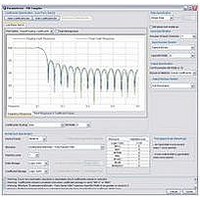IPR-FIR Altera, IPR-FIR Datasheet - Page 35

IPR-FIR
Manufacturer Part Number
IPR-FIR
Description
IP CORE Renewal Of IP-FIR
Manufacturer
Altera
Type
MegaCorer
Specifications of IPR-FIR
Software Application
IP CORE, DSP Filters And Transforms
Supported Families
Arria GX, Arria II GX, Cyclone, HardCopy, Stratix
Core Architecture
FPGA
Core Sub-architecture
Arria, Cyclone, Stratix
Rohs Compliant
NA
Function
Finite Impulse Response Compiler
License
Renewal License
Lead Free Status / RoHS Status
na
Lead Free Status / RoHS Status
na
Chapter 3: Parameter Settings
Specify the Architecture Specification
Specify the Architecture Specification
Table 3–3. Architecture Trade-Offs
© December 2010 Altera Corporation
Distributed
arithmetic
Distributed
arithmetic
Distributed
arithmetic
DSP block
multiplier
Available
option for all
architectures
Technology
1
Fully parallel Large area
Fully serial
Multibit
serial
Multicycle
Pipelining
Option
When adjusting the input and output specification, follow these tips:
■
■
You are now ready to select the architecture parameters from the lower half of the
Parameterize - FIR Compiler page.
The FIR Compiler supports several filter structures, including:
■
■
■
■
For maximum clock speed, select the Distributed Arithmetic: Fully Serial Filter
structure. (For Stratix, Stratix II, Stratix III, or Stratix IV devices, using smaller
memory resources for coefficient and data storage is faster than using larger memory
resources.) For maximum throughput, select the Distributed Arithmetic: Fully Parallel
structure.
When reloading coefficients, a multicycle variable FIR filter structure has a short
reloading time compared to a fixed FIR filter. Additionally, smaller memory blocks
have a shorter reloading time than larger memory blocks.
Table 3–3
For more information about the filter architectures and how they operate, refer to
“FIR Compiler” on page
Truncating from the MSB reduces logic resources more than saturation.
The Number of Input Channels option is useful for designs such as modulators
and demodulators, which have I and Q channels. If you are designing this type of
application, select 2 input channels. This tutorial uses the default settings.
Variable/Fixed coefficient: Multicycle
Distributed arithmetic: Fully Parallel Filter
Distributed arithmetic: Fully Serial Filter
Distributed arithmetic: Multibit Serial Filter
Small area
Medium area
Area depends on the number
of calculation cycles selected
(area increases as the number
of calculation cycles increases)
Creates a higher performance
filter with an area increase.
describes the relative trade-offs for the different architecture options.
Area
4–1.
Creates a fast filter: 140 to over 300 MSPS throughput with
pipelining in Stratix II devices.
Requires multiple clock cycles for a single computation.
Uses several serial units to increase throughput.This results
in greater throughput than fully serial, but less throughput
than fully parallel.
Data throughput increases as the number of calculation
cycles decreases. This architecture takes advantage of
Stratix, Stratix II, Stratix III, or Stratix IV DSP Blocks, and
Cyclone II Multipliers.
Increases throughput with additional latency and size
increase.
Speed (Data Throughput)
FIR Compiler User Guide
3–11















